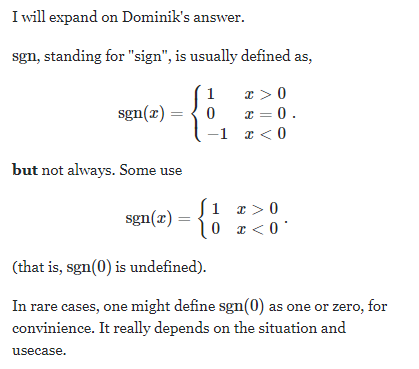signum function
Peggy Frisbie

John Hanna
Apparently there’s a difference between sign() and sgn():
I found (Googled) that:
TI uses the sign(x) (aka ‘signum function’) is the derivative of f(x) = abs(x) which is ‘undefined’ at 0 and they apparently leave it at that.
sgn(0) can be ‘defined’ to be 0.
Subtle differences that make CAS interesting!
Also found:

As a derivative, sign(0) could be +-1 because of the one-sided derivatives.
Also found this from the CX CAS Guidebook:

Explain that!!
Do good,
John
From: tins...@googlegroups.com <tins...@googlegroups.com> On Behalf Of Peggy Frisbie
Sent: Thursday, October 28, 2021 4:31 AM
To: tinspire <tins...@googlegroups.com>
Subject: [tinspire] signum function
The signum function is likely to come up on the calculator in class today, so I was making sure a couple of examples worked. But sign(0) didn't evaluate. Here's what I mean:

I checked MathWorld and Wikipedia to confirm that sgn(0) is supposed to be 0 (and that I wasn't just misremembering). Any idea why this doesn't return an answer?
Whoa, just tried in on my handheld and got sign(0) = ±1. The handheld is on v5.3.0.564 and the computer software on 5.3.2.129.
--
--
To post to this group, send email to tins...@googlegroups.com
To unsubscribe send email to tinspire+u...@googlegroups.com
For more options, visit this group at
http://groups.google.com.au/group/tinspire?hl=en-GB?hl=en-GB
The tns documents shared by group members are archived at
https://sites.google.com/site/tinspiregroup/classroom-news/welcome-abouttime
---
You received this message because you are subscribed to the Google Groups "tinspire" group.
To unsubscribe from this group and stop receiving emails from it, send an email to tinspire+u...@googlegroups.com.
To view this discussion on the web visit https://groups.google.com/d/msgid/tinspire/a1547d67-ebe5-4ed0-9ee6-a6a131c7fd71n%40googlegroups.com.
Peggy Frisbie
Brothers, Gosia
To add to John’s reply, here is the clarification from TI-Nspire development team:
TI-Nspire definition of the complex sign() function comes from the following source: Rich, A. and Jeffrey, D. "Function Evaluation on Branch Cuts." SIGSAM Bull., No. 116, 25-27, June 1996.
Our choice of sign(0) being an indeterminate value (1 or -1 for real zero, an indeterminate value on the unit circle in the complex plane for complex zero) is important for making our limit code work properly - if we set sign(0) to zero then we would have difficulty establishing whether certain limits diverge (e.g. sign(0)*1/x as x-> should diverge - if we set sign(0) to zero then establishing this fact becomes next to impossible).
Also, on TI-Nspire we have a similar convention for handling oscillatory functions as x->infinity. We use "sin(infinity)" for this purpose, representing an indeterminate value between 1 and -1. With this convention we can handle limits like 1/x*sin(x) as x-> infinity (the limit becomes zero, as it should).
Hope this helps,
Gosia Brothers
Texas Instruments
To view this discussion on the web visit https://groups.google.com/d/msgid/tinspire/004e01d7cbeb%2418e73e40%244ab5bac0%24%40optonline.net.
